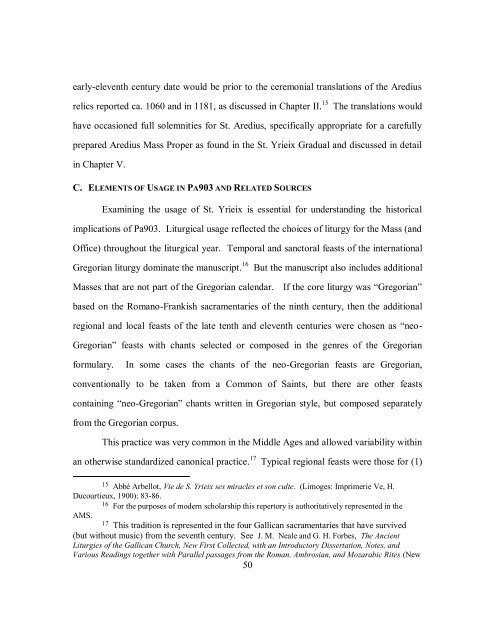Front Matter Template - The University of Texas at Austin
Front Matter Template - The University of Texas at Austin
Front Matter Template - The University of Texas at Austin
You also want an ePaper? Increase the reach of your titles
YUMPU automatically turns print PDFs into web optimized ePapers that Google loves.
early-eleventh century d<strong>at</strong>e would be prior to the ceremonial transl<strong>at</strong>ions <strong>of</strong> the Aredius<br />
relics reported ca. 1060 and in 1181, as discussed in Chapter II. 15 <strong>The</strong> transl<strong>at</strong>ions would<br />
have occasioned full solemnities for St. Aredius, specifically appropri<strong>at</strong>e for a carefully<br />
prepared Aredius Mass Proper as found in the St. Yrieix Gradual and discussed in detail<br />
in Chapter V.<br />
C. ELEMENTS OF USAGE IN PA903 AND RELATED SOURCES<br />
Examining the usage <strong>of</strong> St. Yrieix is essential for understanding the historical<br />
implic<strong>at</strong>ions <strong>of</strong> Pa903. Liturgical usage reflected the choices <strong>of</strong> liturgy for the Mass (and<br />
Office) throughout the liturgical year. Temporal and sanctoral feasts <strong>of</strong> the intern<strong>at</strong>ional<br />
Gregorian liturgy domin<strong>at</strong>e the manuscript. 16 But the manuscript also includes additional<br />
Masses th<strong>at</strong> are not part <strong>of</strong> the Gregorian calendar. If the core liturgy was “Gregorian”<br />
based on the Romano-Frankish sacramentaries <strong>of</strong> the ninth century, then the additional<br />
regional and local feasts <strong>of</strong> the l<strong>at</strong>e tenth and eleventh centuries were chosen as “neo-<br />
Gregorian” feasts with chants selected or composed in the genres <strong>of</strong> the Gregorian<br />
formulary. In some cases the chants <strong>of</strong> the neo-Gregorian feasts are Gregorian,<br />
conventionally to be taken from a Common <strong>of</strong> Saints, but there are other feasts<br />
containing “neo-Gregorian” chants written in Gregorian style, but composed separ<strong>at</strong>ely<br />
from the Gregorian corpus.<br />
This practice was very common in the Middle Ages and allowed variability within<br />
an otherwise standardized canonical practice. 17 Typical regional feasts were those for (1)<br />
15 Abbé Arbellot, Vie de S. Yrieix ses miracles et son culte. (Limoges: Imprimerie Ve, H.<br />
Ducourtieux, 1900): 83-86.<br />
16 For the purposes <strong>of</strong> modern scholarship this repertory is authorit<strong>at</strong>ively represented in the<br />
AMS.<br />
17 This tradition is represented in the four Gallican sacramentaries th<strong>at</strong> have survived<br />
(but without music) from the seventh century. See J. M. Neale and G. H. Forbes, <strong>The</strong> Ancient<br />
Liturgies <strong>of</strong> the Gallican Church, New First Collected, with an Introductory Dissert<strong>at</strong>ion, Notes, and<br />
Various Readings together with Parallel passages from the Roman, Ambrosian, and Mozarabic Rites (New<br />
50

















